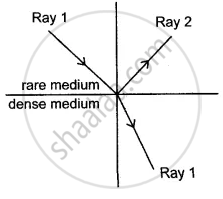Advertisements
Advertisements
प्रश्न
A ray of light falls normally on the surface of a transparent glass slab. Draw a ray diagram to show its path and also mark angle of incidence and angle of emergence.
उत्तर

As the incident light is normal to the surface thus the incidence angle will be zero which will correspond to zero degree refracted angle and zero degree emergent angle.
APPEARS IN
संबंधित प्रश्न
Which colour of light travels fastest in any medium except air?
How can you bend light away from the normal?
How is the refractive index of a medium related to the speed of light in it?
When light travels from a rarer to a denser medium, its speed ______.
Four students showed the following traces of the path of a ray of light passing through a rectangular glass slab.

The trace most likely to be correct is that of student
(A) I
(B) II
(C) III
(D) IV
Define the term refractive index of a medium in terms of velocity of light.
A ray of light moves from a rare medium to a dense medium as shown in the diagram below. Write down the number of the ray which represents the partially reflected ray.

Trace a ray of light incident at 30° on a surface if travelling from glass to air. What is the angle of refraction in this case? (R.I. for glass = 3/2).
Explain with the help of a diagram of how fish is able to see the objects above it.
Consider these indices of refraction: glass: 1.52; air: 1.0003; water: 1.333. Based on the refractive indices of three materials, arrange the speed of light through them in decreasing order.
